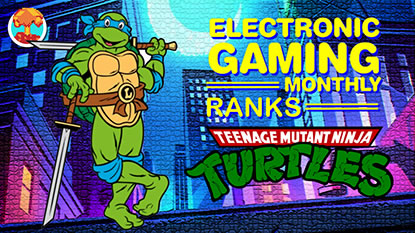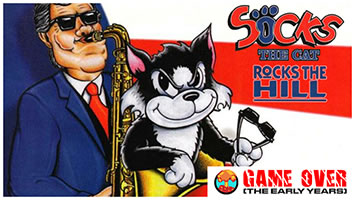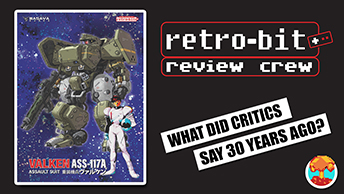- CLASSIC MAGAZINES
- REVIEW CREW
A show recapping what critics thought back
when classic games first came out! - NEXT GENERATION'S BEST & WORST
From the worst 1-star reviews to the best
5-stars can offer, this is Next Generation! - NINTENDO POWER (ARCHIVE)
Experience a variety of shows looking at the
often baffling history of Nintendo Power! - MAGAZINE RETROSPECTIVE
We're looking at the absolutely true history of
some of the most iconic game magazines ever! - SUPER PLAY'S TOP 600
The longest and most ambitious Super NES
countdown on the internet! - THEY SAID WHAT?
Debunking predictions and gossip found
in classic video game magazines! - NEXT GENERATION UNCOVERED
Cyril is back in this spin-off series, featuring the
cover critic review the art of Next Generation! - HARDCORE GAMER MAGAZING (PDF ISSUES)
Download all 36 issues of Hardcore Gamer
Magazine and relive the fun in PDF form!
- REVIEW CREW
- ELECTRONIC GAMING MONTHLY
- ELECTRONIC GAMING MONTHLY RANKS
From Mario to Sonic to Street Fighter, EGM
ranks classic game franchises and consoles! - ELECTRONIC GAMING MONTHLY BEST & WORST
Counting down EGM’s best and worst reviews
going year by year, from 1989 – 2009! - ELECTRONIC GAMING BEST & WORST AWARDS
11-part video series chronicling the ups and
downs of EGM’s Best & Worst Awards!
- ELECTRONIC GAMING MONTHLY RANKS
- GAME HISTORY
- GAME OVER: STORY BREAKDOWNS
Long-running series breaking down game
stories and analyzing their endings! - A BRIEF HISTORY OF GAMING w/ [NAME HERE]
Real history presented in a fun and pithy
format from a variety of game historians! - THE BLACK SHEEP
A series looking back at the black sheep
entries in popular game franchises! - INSTANT EXPERT
Everything you could possibly want to know
about a wide variety of gaming topics! - FREEZE FRAME
When something familiar happens in the games
industry, we're there to take a picture! - I'VE GOT YOUR NUMBER
Learn real video game history through a series
of number-themed episodes, starting at zero! - GREAT MOMENTS IN BAD ACTING
A joyous celebration of some of gaming's
absolute worst voice acting!
- GAME OVER: STORY BREAKDOWNS
- POPULAR SHOWS
- DG NEWS w/ LORNE RISELEY
Newsman Lorne Riseley hosts a regular
series looking at the hottest gaming news! - REVIEW REWIND
Cyril replays a game he reviewed 10+ years
ago to see if he got it right or wrong! - ON-RUNNING FEUDS
Defunct Games' longest-running show, with
editorials, observations and other fun oddities! - DEFUNCT GAMES QUIZ (ARCHIVE)
From online quizzes to game shows, we're
putting your video game knowledge to the test!- QUIZ: ONLINE PASS
Take a weekly quiz to see how well you know
the news and current gaming events! - QUIZ: KNOW THE GAME
One-on-one quiz show where contestants
find out if they actually know classic games! - QUIZ: THE LEADERBOARD
Can you guess the game based on the classic
review? Find out with The Leaderboard!
- QUIZ: ONLINE PASS
- DEFUNCT GAMES VS.
Cyril and the Defunct Games staff isn't afraid
to choose their favorite games and more! - CYRIL READS WORLDS OF POWER
Defunct Games recreates classic game
novelizations through the audio book format!
- DG NEWS w/ LORNE RISELEY
- COMEDY
- GAME EXPECTANCY
How long will your favorite hero live? We crunch
the numbers in this series about dying! - VIDEO GAME ADVICE
Famous game characters answer real personal
advice questions with a humorous slant! - FAKE GAMES: GUERILLA SCRAPBOOK
A long-running series about fake games and
the people who love them (covers included)! - WORST GAME EVER
A contest that attempts to create the worst
video game ever made, complete with covers! - LEVEL 1 STORIES
Literature based on the first stages of some
of your favorite classic video games! - THE COVER CRITIC
One of Defunct Games' earliest shows, Cover
Critic digs up some of the worst box art ever! - COMMERCIAL BREAK
Take a trip through some of the best and
worst video game advertisements of all time! - COMIC BOOK MODS
You've never seen comics like this before.
A curious mix of rewritten video game comics!
- GAME EXPECTANCY
- SERIES ARCHIVE
- NINTENDO SWITCH ONLINE ARCHIVE
A regularly-updated list of every Nintendo
Switch Online release, plus links to review! - PLAYSTATION PLUS CLASSIC ARCHIVE
A comprehensive list of every PlayStation
Plus classic release, including links! - RETRO-BIT PUBLISHING ARCHIVE
A regularly-updated list of every Retro-Bit
game released! - REVIEW MARATHONS w/ ADAM WALLACE
Join critic Adam Wallace as he takes us on a
classic review marathon with different themes!- DEFUNCT GAMES GOLF CLUB
Adam Wallace takes to the links to slice his way
through 72 classic golf game reviews! - 007 IN PIXELS
Adam Wallace takes on the world's greatest spy
as he reviews 15 weeks of James Bond games! - A SALUTE TO VAMPIRES
Adam Wallace is sinking his teeth into a series
covering Castlevania, BloodRayne and more! - CAPCOM'S CURSE
Adam Wallace is celebrating 13 days of Halloween
with a line-up of Capcom's scariest games! - THE FALL OF SUPERMAN
Adam Wallace is a man of steel for playing
some of the absolute worst Superman games! - THE 31 GAMES OF HALLOWEEN
Adam Wallace spends every day of October afraid
as he reviews some of the scariest games ever! - 12 WEEKS OF STAR TREK
Adam Wallace boldly goes where no critic has
gone before in this Star Trek marathon!
- DEFUNCT GAMES GOLF CLUB
- DAYS OF CHRISTMAS (ARCHIVE)
Annual holiday series with themed-episodes
that date all the way back to 2001!- 2015: 30 Ridiculous Retro Rumors
- 2014: 29 Magazines of Christmas
- 2013: 29 Questionable Power-Ups of Christmas
- 2012: 34 Theme Songs of Christmas
- 2011: 32 Game Endings of Christmas
- 2010: 31 Bonus Levels of Christmas
- 2009: 30 Genres of Christmas
- 2008: 29 Controls of Christmas
- 2007: 34 Cliches of Christmas
- 2006: 33 Consoles of Christmas
- 2005: 32 Articles of Christmas
- 2004: 31 Websites of Christmas
- 2003: 29 Issues of Christmas
- 2002: 28 Years of Christmas
- 2001: 33 Days of Christmas
- NINTENDO SWITCH ONLINE ARCHIVE
- REVIEW ARCHIVE
- FULL ARCHIVE
Story Breakdown: Bionic Commando (Arcade & NES)
Welcome to the fourteenth episode of 23 Endings: The Early Years, the show where we put old school video game endings into proper context. Put down that game controller and grab your grappling hook, because Super Joe needs your help. Today we're going to find out which Bionic Commando ending is best -- Nintendo Entertainment System, Game Boy or arcade. Find out now when you watch today's episode of 23 Endings: The Early Years!
Launched in arcades back in 1987, Bionic Commando was initially sold as a follow-up to the overhead shoot 'em up Commando. You took control of Super Joe as he parachuted behind enemy lines and used his grappling hook to infiltrate the enemy base and foil the army's plot to launch a missile. We don't really get a lot of details setting this up, we just know that it takes place a decade after an unspecified World War and requires a hero with a special set of skills.
This arcade game is short and only features four brief levels. We start out in a forest flooded with guards. This makes way for the enemy outpost, followed by an underground base. It all leads to a final confrontation with this giant computer, which leads into a frantic race to escape the compound in one piece. Here's what happens if you do all this correctly.
Okay, it's not the world's most satisfying ending, but it reminds us that we simply played a small part in a much larger war. It leaves it open ended and encourages you to restart the game from the beginning to earn a higher score. In other words, it's an arcade game from the mid-1980s. This is what you get.
When it comes to the 1988 NES port, you can go ahead and forget about the arcade story. Capcom decided to completely retool the home version, giving us brand new characters and a completely different story. This time around we find Super Joe captured after attempting to infiltrate Generalissimo Killt's base in order to uncover a top secret project known as "Albatros." Now it's up to Nathan "Ladd" Spencer to swoop in and not only save Super Joe, but figure out what the evil Nazz group is planning.
Long story short, Spencer fights through all kinds of stages and eventually infiltrates the Nazz base. It's here where he discovers that Generalissimo Killt has been keeping a brutal dictator named Master-D preserved in some sort of liquid and has been trying to bring him back to life. Now, here's where things start to get interesting. Remember how the instruction manual calls this group the Nazz, well Master-D looks an awful lot like a certain dictator that died on April 30, 1945. In fact, the likeness is so obvious that Capcom felt the need to change the group's name from Nazz to Badd inside the game. No matter what you call the evil army, it's pretty clear that this is Hitler.
So Spencer gets there just in time to see Generalissimo Killt resurrect Hitler ... I mean Master-D. We also learn that the top secret Albatros weapon has come online and our hero is going to need to take it down. This leads to a chance meeting with a fellow Federation soldier that has a bazooka waiting for Spence. The mission now is to jump towards the chopper, line up a shot, and then kill both Generalissimo Killt and Hitler before they escape. Here's how that works out.
With Nazz's leadership killed, it's up to Spencer to find his way out of the base before the whole thing blows up. Here's what happens next.
While everybody is excited that Spencer saved the day and rescued Super Joe, I want to go back to the moment when he blew up Hitler's head. It goes by so quickly, but this is easily one of the most gruesome endings I've ever seen on the Nintendo Entertainment System. It's so much that I'm a little surprised it made it past Nintendo's strict guidelines. Throw in the Hitler and Nazi stuff and it makes me wonder if anybody at Nintendo bothered playing to the end. But I did, and this iconic ending has stuck with me for close to thirty years.
Four years after NES owners fell in love with shooting Hitler in the face, Capcom decided to port the game to the handheld Game Boy. Instead of completely retooling the game (as they did when going from the arcade to NES), the developers simply changed the year, localization and changed some of the names. For example, Ladd Spencer became Rad Spencer and Generalissimo Killt's name was changed back to Director Wiseman, a reference to the original Famicom version. This brand new black and white Bionic Commando also found itself set in the future, giving Capcom the incentive to update some of the visuals and add more spiky hair.
But it's not the setting or the hairstyles that you're probably interested in, so let's jump to the very end and see if the blood and guts remain.
As you can see, Capcom ditched 8-bit Hitler. Sadly, they also got rid of the gory head explosion, opting instead for a bunch of sci-fi nonsense that isn't nearly as exciting or iconic as the NES game. That said, I like the animation on the exploding ship and some of the shots they have after it. This black and white ending isn't as memorable, but it's appropriately satisfying and pretty good for a Game Boy game.
Now let's talk about how "Rad" Spencer's wife ends up being locked away inside his bionic arm in the new game. On second thought, let's not.
Launched in arcades back in 1987, Bionic Commando was initially sold as a follow-up to the overhead shoot 'em up Commando. You took control of Super Joe as he parachuted behind enemy lines and used his grappling hook to infiltrate the enemy base and foil the army's plot to launch a missile. We don't really get a lot of details setting this up, we just know that it takes place a decade after an unspecified World War and requires a hero with a special set of skills.
This arcade game is short and only features four brief levels. We start out in a forest flooded with guards. This makes way for the enemy outpost, followed by an underground base. It all leads to a final confrontation with this giant computer, which leads into a frantic race to escape the compound in one piece. Here's what happens if you do all this correctly.
Okay, it's not the world's most satisfying ending, but it reminds us that we simply played a small part in a much larger war. It leaves it open ended and encourages you to restart the game from the beginning to earn a higher score. In other words, it's an arcade game from the mid-1980s. This is what you get.
When it comes to the 1988 NES port, you can go ahead and forget about the arcade story. Capcom decided to completely retool the home version, giving us brand new characters and a completely different story. This time around we find Super Joe captured after attempting to infiltrate Generalissimo Killt's base in order to uncover a top secret project known as "Albatros." Now it's up to Nathan "Ladd" Spencer to swoop in and not only save Super Joe, but figure out what the evil Nazz group is planning.
Long story short, Spencer fights through all kinds of stages and eventually infiltrates the Nazz base. It's here where he discovers that Generalissimo Killt has been keeping a brutal dictator named Master-D preserved in some sort of liquid and has been trying to bring him back to life. Now, here's where things start to get interesting. Remember how the instruction manual calls this group the Nazz, well Master-D looks an awful lot like a certain dictator that died on April 30, 1945. In fact, the likeness is so obvious that Capcom felt the need to change the group's name from Nazz to Badd inside the game. No matter what you call the evil army, it's pretty clear that this is Hitler.
So Spencer gets there just in time to see Generalissimo Killt resurrect Hitler ... I mean Master-D. We also learn that the top secret Albatros weapon has come online and our hero is going to need to take it down. This leads to a chance meeting with a fellow Federation soldier that has a bazooka waiting for Spence. The mission now is to jump towards the chopper, line up a shot, and then kill both Generalissimo Killt and Hitler before they escape. Here's how that works out.
With Nazz's leadership killed, it's up to Spencer to find his way out of the base before the whole thing blows up. Here's what happens next.
While everybody is excited that Spencer saved the day and rescued Super Joe, I want to go back to the moment when he blew up Hitler's head. It goes by so quickly, but this is easily one of the most gruesome endings I've ever seen on the Nintendo Entertainment System. It's so much that I'm a little surprised it made it past Nintendo's strict guidelines. Throw in the Hitler and Nazi stuff and it makes me wonder if anybody at Nintendo bothered playing to the end. But I did, and this iconic ending has stuck with me for close to thirty years.
Four years after NES owners fell in love with shooting Hitler in the face, Capcom decided to port the game to the handheld Game Boy. Instead of completely retooling the game (as they did when going from the arcade to NES), the developers simply changed the year, localization and changed some of the names. For example, Ladd Spencer became Rad Spencer and Generalissimo Killt's name was changed back to Director Wiseman, a reference to the original Famicom version. This brand new black and white Bionic Commando also found itself set in the future, giving Capcom the incentive to update some of the visuals and add more spiky hair.
But it's not the setting or the hairstyles that you're probably interested in, so let's jump to the very end and see if the blood and guts remain.
As you can see, Capcom ditched 8-bit Hitler. Sadly, they also got rid of the gory head explosion, opting instead for a bunch of sci-fi nonsense that isn't nearly as exciting or iconic as the NES game. That said, I like the animation on the exploding ship and some of the shots they have after it. This black and white ending isn't as memorable, but it's appropriately satisfying and pretty good for a Game Boy game.
Now let's talk about how "Rad" Spencer's wife ends up being locked away inside his bionic arm in the new game. On second thought, let's not.
HOME |
CONTACT |
NOW HIRING |
WHAT IS DEFUNCT GAMES? |
NINTENDO SWITCH ONLINE |
RETRO-BIT PUBLISHING
Retro-Bit |
Switch Planet |
The Halcyon Show |
Same Name, Different Game |
Dragnix |
Press the Buttons
Game Zone Online | Hardcore Gamer | The Dreamcast Junkyard | Video Game Blogger
Dr Strife | Games For Lunch | Mondo Cool Cast | Boxed Pixels | Sega CD Universe | Gaming Trend
Game Zone Online | Hardcore Gamer | The Dreamcast Junkyard | Video Game Blogger
Dr Strife | Games For Lunch | Mondo Cool Cast | Boxed Pixels | Sega CD Universe | Gaming Trend
Copyright © 2001-2025 Defunct Games
All rights reserved. All trademarks are properties of their respective owners.
All rights reserved. All trademarks are properties of their respective owners.

























